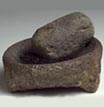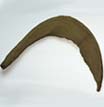
|
| In parts of the Near East today, people's lives are in some ways very
similar to their ancestors' thousands of years ago. Researchers can observe
today's lifestyles along with archaeological evidence from the past to
better understand the people of the ancient Near East. Let's look at how
people supported themselves over thousands of years and how their lifestyles
developed in the "cradle of civilization."
Hunter-Gatherers: For thousands of years small bands of nomadic people hunted wild animals and gathered native plants to eat. Very few objects made by these people have survived. Can you think of other parts of the world where people have lived as hunter-gatherers? Think about it for a minute. See if you thought of some of the same cultures we did. Agricultural Villages: Around 10,000 B.C. some people living in the ancient Near East discovered a new way of obtaining food - they began to grow grain and raise animals rather than finding these food sources in the wild. This new way of life allowed them to set up permanent villages because they didn't have to travel in search of food. At first these villages sprang up in places with enough rainfall to grow crops. Later the farmers started to irrigate the fields, and the harvests became more abundant and predictable.
|
| Here are some objects that archaeologists have found
from early agricultural villages:
|
 |
 |
|
As these villages grew larger and more prosperous, Cities and then Kingdoms & Empires began to develop.
|
 |
 |
 |
 |
 |
 |
 |
© Michael C. Carlos Museum of Emory University,
Memorial Art Gallery of the University of Rochester and Dallas Museum of Art
For more information please contact odyssey@emory.edu.
Last Update: